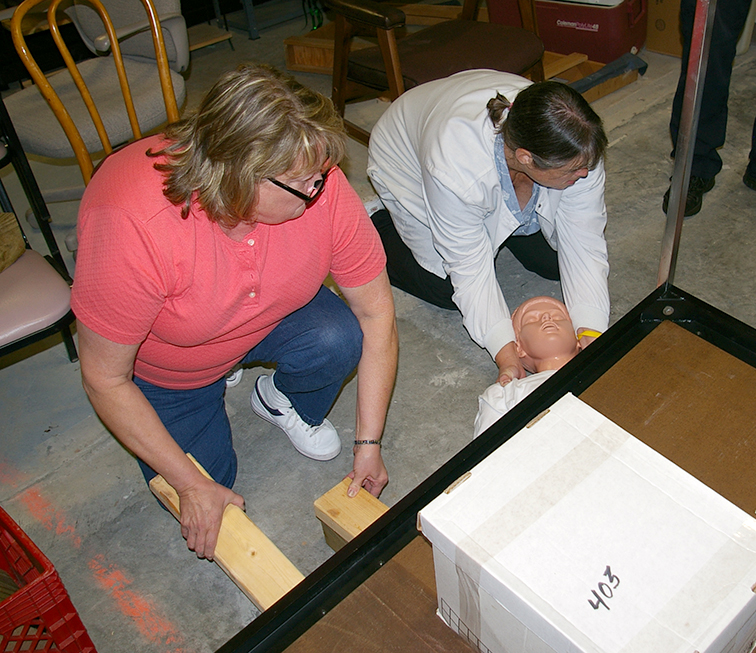 KANSAS CITY, Mo. — Disaster, by its very nature, tends to strike when least expected, often leaving victims in the wake feeling devastated and at the mercy of strangers.
KANSAS CITY, Mo. — Disaster, by its very nature, tends to strike when least expected, often leaving victims in the wake feeling devastated and at the mercy of strangers.
While there are many assistance organizations available to help, Platte County has its own unique emergency response relief system in Northland CERT, which might help those surviving a disaster feel just a little less alone through assistance by members of their own community. The Community Emergency Response Team (CERT) concept was formed in 1993 as part of the federal Citizen Corps and features thousands of teams nationwide.
More locally, there are 14 teams in the Kansas City metro area. Formed in 2003, Northland CERT serves all of Platte County with Platte County Sheriff’s Office Capt. Mike O’Neal in charge.
Just in time for National Preparedness Month in September, Northland CERT held a basic training course spread across two weekends in late August at the Platte County Resource Center with about a dozen interested Northland residents enrolled.
“We want you to take care of yourselves first — you and your family first, so then you can help others,” O’Neal told the class. “Then you can help your neighbors and community to survive the first 48 to 72 hours of a disaster. But first, we want you to be able to take care of yourselves and your families. You’re no good to anybody else if you’re worried about your own family.”
According to the Northland CERT website, located at northlandcert.readytohelp.org, many people have been injured or even killed trying to help themselves, their family or their neighbors. The CERT concept came about to help people respond safely.
The course featured an overview on putting out minor fires with a fire extinguisher, disaster first aid and triage and search and rescue techniques for use in structures with light to moderate damage.
Additionally, students learned about the organization of CERT, disaster psychology and the effects of trauma on victims and first responders and terrorism awareness.
Taught by O’Neal and volunteers Peter Sturner, Allen Wrinkle and Cathy Gabel, the course spanned three sessions.
Students attended for many reasons: work, their own information or brushing up on previous skills learned. Among those were three Platte City natives — Ann Compton, Carol Morlan and current CERT member Pat Steece, who was there for a refresher course.
Compton has some previous experience with disaster.
As a Federal Emergency Management Administration (FEMA) reservist, she’s handled preliminary damage assessments after the Joplin, Mo. tornado in 2011 and Hurricane Sandy in New York in 2012.
“I’ve been out on disasters, but I’ve learned a lot from this,” Compton said of the class. “It’s been a big help and provided a lot of good information about things you don’t always think about. Volunteers are no help if they don’t have training and organization.”
Sturner previously served as chief of the South Platte Fire Protection District and worked as a criminal justice instructor at Park University in Parkville, Mo. before his retirement. Now, he’s teaching civilians how to stay safe, not just in major disasters but more minor ones as well — such as power outages.
According to Sturner, most people don’t know that it’s a smart idea to turn off the main circuit breaker during power outages.
“Think about all those things you run power to in your house, and a lot of it is just sitting there in standby mode,” Sturner told the class. “When the power returns, all those devices try to power up all at once and can overload circuits, potentially leading to more outages — or a fire.”
The course included a practical firefighting exercise, a hands-on first aid and injury assessment demonstration as well as a search and rescue drill.
“We’re just going to break you up into groups and let you figure this out on your own,” Wrinkle told the class, asserting that anyone can do something to help in any disaster situation. “Don’t let anyone tell you otherwise. You know what you can do better than anyone, so don’t think you can’t do anything to help.”
O’Neal agreed, recalling elderly CERT volunteers who did logistics work, collecting names of victims and coordinating paperwork.
While much of the course focused on the practical end of dealing with disaster, it closed with the aftermath. O’Neal shared personal stories of dealing with disaster and the importance of talking about the experiences shared during a life-changing event. CERT team members are debriefed after missions and encouraged to become a support system for one another.
“It’s very important to talk about what you’ve seen, what might have bothered you — what didn’t bother you,” O’Neal said. “If these things aren’t discussed, they’ll eat you up.”
Those completing the course receive a certificate, and the option of ending their emergency preparation training there or joining the team. After completion, Morlan plans to join the Northland CERT team.
“I’ve been wanting to take this class for quite a while,” Morlan said. “I took a similar class a long time ago, and I have experience in the medical field. I volunteer at Hillcrest, and I think this is beneficial to help in all kinds of situations."
For those interested in continuing their training, such as Steece and Morlan, Northland CERT offers advanced training such as CPR refresher classes, weather spotting through the National Weather Service, chain saw operations and debris removal and advanced first aid training through the Medical Reserve Corps.


